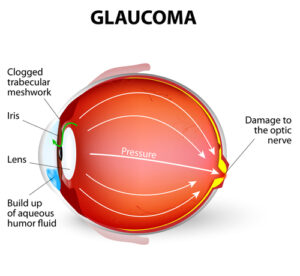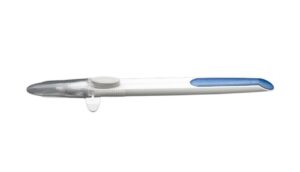Did you know that one of the leading causes of blindness, especially in adults over 60, is glaucoma? Glaucoma is an eye condition that affects the optic nerve.
When the optic nerve becomes damaged, it’s irreversible, leading to pressure that builds up in the eye over time that presses on the optic nerve. The pressure in the eye is due to fluid in the eye that cannot escape, leading to vision loss.
If you’ve heard the term the silent thief of vision about glaucoma, it’s because the condition has almost no discernible symptoms. Most people don’t realize they have glaucoma until they’ve already started losing their sight. Any vision loss due to optic nerve damage is permanent.
However, you can manage glaucoma to prevent or slow further vision loss. See Clearly Vision is now proud to offer our glaucoma patients a new treatment option called Durysta.
Durysta is the first treatment of its kind available for patients with open-angle glaucoma who struggle to take daily eye drops to regulate their intraocular pressure. Keep reading to learn more about Durysta and to find out if it may be right for you!
What is Glaucoma?

Glaucoma is a group of eye conditions that can come in several forms. The most common types of glaucoma are caused by high intraocular pressure (IOP), usually due to fluid building up in the eyes.
Primary Open-Angle Glaucoma
The most common form of glaucoma is called primary open-angle glaucoma. In open-angle glaucoma, the primary drainage channel, or angle, is open in the front of your eye.
Pressure builds because it can’t drain through the tissue that surrounds the eye. The tissue that surrounds the eye is made up of something called the trabecular meshwork.
The trabecular meshwork is the path that fluid uses to leave the back of the eye and drain out the front. In this form of glaucoma, the trabecular meshwork becomes clogged, closed, or blocked off and will no longer allow fluid to drain from the eye.
Closed-Angle Glaucoma
Closed-angle glaucoma is a rarer condition that develops more quickly than open-angle glaucoma. It occurs when the iris bulges or is moved to block the primary drainage angle.
The blockage of the primary drainage angle often happens very quickly. If this occurs, it’s called acute angle-closure glaucoma and is a medical emergency.
This kind of glaucoma does present apparent and painful symptoms. These include:

- Sudden loss of vision
- Eye pain
- Nausea
- Vomiting
- Headaches that don’t get better after taking pain medication
- Eyes that look red
If you experience these symptoms, you’ll need to see a doctor as soon as possible. To save your remaining vision, you must receive prompt treatment if you have closed-angle glaucoma. If this form of glaucoma is not treated, it could result in rapid loss of sight.
Most glaucoma patients have open-angle glaucoma. Unless you have regular eye exams, the condition can steal your vision before you receive a diagnosis. That’s why it’s so crucial to schedule regular eye exams and receive prompt treatment if necessary.
The Long-Term Effects of Optic Nerve Damage
When intraocular pressure is too high, it puts strain on the optic nerve. The optic nerve is what relays what you see from your eye to your brain.
When it becomes damaged, it can’t relay the whole picture. This results in patches of blank vision and, eventually, tunnel vision that becomes narrower and narrower.
Glaucoma has no cure, but it can be diagnosed early and treated effectively to slow its progression. Having regular eye exams is the only way to do this.
Your eye doctor at See Clearly Vision will measure your IOP, and if your levels are high, these are one of the earliest signs of glaucoma. Even in the earliest stages before optic nerve damage has occurred, you can start treatment.
Treatment Options

There are several ways to treat glaucoma. One of the primary treatment methods is in the form of taking daily eye drops. The eye drops help lower your intraocular pressure levels.
There are also surgical procedures for more advanced cases of glaucoma that work to drain fluid from the eye in various ways. Depending on the severity of your glaucoma, treatment may include a mix of medication and surgery.
But if you don’t want surgery or struggle to remember to take eye drops every day, you may be a good candidate for a new implantable medication called Durysta.
What is Durysta?
Durysta is the only FDA-approved dissolvable implant for patients with open-angle glaucoma or high eye pressure. The implant is placed into the eye and dissolves slowly over several months.
During this time, the implant administers a medication called bimatoprost. Bimatoprost lowers your IOP. By having the implant, you can manage your intraocular pressure levels for several months. The best part is that you can reduce your IOP without needing to take eye drops daily.

Your eye doctor at See Clearly Vision will implant Durysta into one eye at a time, where it will dissolve on its own. The implant lasts 15 weeks and provides continuous medicine in the eye to reduce elevated eye pressure.
Many patients who have had Durysta implanted have even noticed lower intraocular pressure levels after the implant dissolved!
Who is a Good Candidate for Durysta?
Although many things make Durysta a fantastic treatment option, it’s not right for every glaucoma patient. Durysta is best for patients that find it difficult to take daily eye drops for their glaucoma.
However, it’s only for patients with open-angle glaucoma or high eye pressure. If you have another form of glaucoma, like closed-angle glaucoma, you’ll need to seek an alternative treatment option.

Durysta is also suited for patients with high intraocular pressure who may be at an increased risk of developing glaucoma. The implant works well as a preventative measure, slowing any potential damage to the optic nerve.
As with most treatments, you shouldn’t have any other pre-existing eye conditions that may interfere with Durysta. Make sure you discuss your medical history with your ophthalmologist at See Clearly Vision if you’re considering Durysta.
In most cases, if you’re in good health and have open-angle glaucoma or are at an increased risk for developing glaucoma, Dursyta could be right for you.
Ready to say goodbye to remembering to take eye drops for glaucoma every day? Find out if Durysta may be right for you by scheduling an appointment at See Clearly Vision at one of our locations in Arlington and Tysons Corner!



















